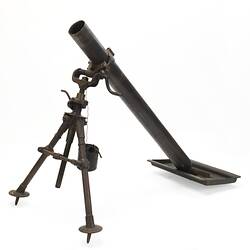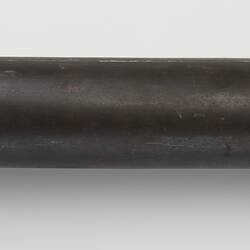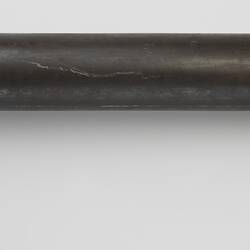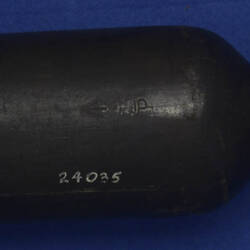Summary
Stokes mortar, 3" bore, British, World War I, with accessories. Consists of steel base plate, bipod mount and tube, with leather muzzle cover. The accessories comprise five canvas ammunition shoulder packs, a length of rope looped at both ends, a tin container with perforated pourer, a canvas shoulder bag and metal accessories. The set is housed in large wooden box, painted khaki.
The Stokes mortar was designed in early 1915 by Frederick Wilfred Scott Stokes. It was a very basic weapon, consisting of a smoothbore metal tube fixed to a base plate for recoil, and mounted on a lightweight tripod. Dropping a bomb into the tube caused a firing pin at the base of the tube to detonate, propelling the bomb up the tube. The Stokes mortar could be readily moved, an advantage during gas attacks. The 4" (aka 4.2") version of the Stokes mortar was itself used to deliver gas shells (in addition to the Livens projector); however, the 3" version was rarely used for this purpose.
According to General Sir Martin Farndale, there were 1,636 Stokes mortars on the Western Front by the end of World War I.
Physical Description
Consists of steel baseplate, bipod mount & tube 1295 mm long, with leather muzzle cover. Includes five canvas ammunition shoulder packs, a length of rope looped at both ends, a tin container with perforated pourer, a canvas shoulder bag and metal accessories. The set is housed in large wooden box, painted khaki.
More Information
-
Collecting Areas
-
Acquisition Information
Donation from Australian War Memorial (AWM), 1955
-
Place & Date Made
-
Inscriptions
Marked '3 ml. Stokes Howitzer. 3452'. Has broad arrow & 'P' below a crown. Other legible markings are 'no 2987 Hover Co 24/9/16'. No markings on mount.
-
Model Name or Number
-
Brand Names
-
Classification
-
Category
-
Discipline
-
Type of item
-
Overall Dimensions
920 mm (Length), 740 mm (Width), 1120 mm (Height), 46 kg (Weight)
Size and weight when assembled as used.
-
References
Stokes Mortar, Wikipedia, [Link 1] accessed 3/2/2014 General Sir Martin Farndale, History of the Royal Regiment of Artillery. Western Front 1914-18. London: Royal Artillery Institution, 1986 Ben Shephard, 2000. A War of Nerves, Harvard University Press, p.63 R. Harris & J. Paxman, A Higher Form of Killing, London: Random House, 1983
-
Keywords
Artillery, Mortar Weapons, World War I, 1914-1918, Gas Warfare





